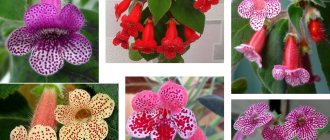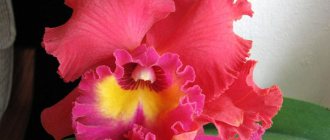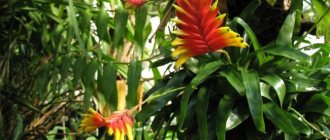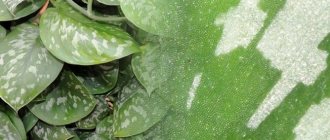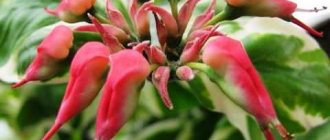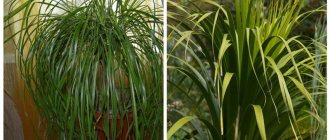A peduncle with bright bracts, combined with variegated foliage and an unusual lifestyle, could not help but attract the attention of flower growers. Today, the Vriesia splenriet shown in the photo is one of the most popular potted plants all over the world.
History of Vriesia
This flower was first discovered in the forests of South and Central America. It was studied and described by the Dutch botanist Willem Hendrik de Vriese. The flower was named after him. Its correct name sounds like “friesia” and it would be more correct to call it that way. But in our country, the compilers of the directory of indoor plants, without hesitation, translated it through the first letter “B”. This is where the distortion came from, because of which we call the flower Vriesia.
Important! Do not confuse Frisea (vriesia) with freesia (freesia, lat. Freesia). The latter belongs to the Iris (Kasatikov) family. This is a genus of African perennial herbaceous corms.
Freesia
Indoor varieties
About 250 species are known in the wild. More than half of them get along well in apartments. Seven varieties are most widespread.
- Astrid. A distinctive feature is a very long flowering time - up to four months. Produces five flower stalks up to a meter long. Inflorescences are yellow or red. The leaves are light in color, with a smooth surface.
- Mix. The peduncles are tall, the inflorescences are characterized by branching. They harmoniously combine yellow and red shades. The bracts are scaly, the leaves are strong, evenly colored.
- Keeled. A distinctive feature is a thin bract with a sharp keel at the top and a yellow or green edge. The leaves are rich green in color and arched. The length of the peduncle is up to half a meter.
- Royal. Very large, beautiful variety. A distinctive feature is the large leaves of a gray-green hue. Inflorescence paniculate: flowers yellow-white, bracts pink.
- Perforated. It stands out not only for its beautiful flowering, but also for its unusual leaves. Their colors are light, the surface is decorated with longitudinal and transverse dark stripes and veins. The tip of the leaf has a reddish-brown edge. Vriesia blooms with yellow flowers with greenish spotted bracts. The inflorescence characteristic of the species is spike-shaped.
- Sanders. The leaves are leathery, elliptical, pointed at the ends. The surface is rough. On the underside there are spots of purple or brownish tints. The inflorescence is yellow-green, paniculate.
- Gigantic. It is better known under another name - chess vriesia. It was named so for its spotted yellow-green color. The leaves are shortened, belt-shaped, very dense. It blooms infrequently in an apartment - it is grown for its beautiful leaves.
Flowering occurs mainly in the summer. The exact timing of flowering depends on the time of planting. If the vriesia does not bloom, it means that the conditions of detention have been violated. Reviews from experienced flower growers contain an interesting way to stimulate flowering. Vriesia will form flower stalks faster under the influence of small doses of ethylene released by ripe fruits. Several bananas are placed on the surface of the soil - this speeds up the formation of the peduncle.
Botanical description of Vriesia
Vriesia is an ornamental perennial of the Bromeliad family. In its natural habitat, it is an epiphyte, as it prefers to grow by clinging to its taller neighbors. This arrangement gives it an advantage, since the vriesea receives more light and practically does not compete with other plants for water and oxygen.
In nature, it is most often found in the tropics of South and Central America, in the south of Brazil and Argentina, as well as in Western India.
Leathery leaves with smooth edges grow in such a way that a rosette is formed at their base. It serves as a container for collecting rainwater, which the flower feeds on. The leaf width can reach 8 cm, and the length – 80 cm. The color of the plate depends on the variety.
During the flowering period, a peduncle appears; its length can reach 1 meter. Inflorescences are spike-shaped, multi-flowered. The color can be monochromatic or multi-colored, it depends on the variety. The peduncle lasts for a very long time, more than a month. At the end of flowering, a fruit appears in the form of a box with seeds.
The root system of Vriesea is poorly developed; the epiphytes, to which this plant belongs, practically do not use the roots for nutrition, they only cling to the support for life above the surface of the earth. The flower receives all the main nutritional elements from the leaf rosette. In tropical conditions, sometimes up to 4.5 liters of water can accumulate in it.
You may be interested in: All about growing guzmania (guzmania).
Vriesia Astrid - characteristic features of the species
It is quite easy to recognize Astrid, because the flower is strikingly different from other types of Vriesea brilliantis, to which it belongs. First of all, these are the compact dimensions of the bush: its height is a maximum of 45 cm. And although the leaves have the same deep green color, the shape and structure of the leaf plate is completely different. Instead of rather wide leathery leaves, Astrid has soft thin leaves, slightly curled at the tips.
But what the variety can especially please you with is its long flowering. Moreover, the flower arrow often exceeds the height of the rosette by 2 times. Vriesia blooms for almost 4 months - longer than all other species. This usually happens closer to summer. In addition, one bush is capable of producing at least 5 flower stalks. Can a single spikelet compare with it, even with a bright color? By the way, about color: the spike-shaped inflorescence is crimson-red, sometimes there is a yellow or orange version.
Planting and caring for vriesia depending on the time of year in the table
| Season | Features of watering | Light | Air humidity, % | Temperature |
| Spring | Lightly moisten the soil. Water the outlet 2 times a week, first pouring out the remaining water from the previous watering. | Bright but slightly diffused | 70-80 | +24…+26 °C |
| Summer | Watering the soil is carried out as it dries. The outlet needs to be watered every three days. | During the daytime, it is necessary to cover the plant from direct sunlight. | 70-80. When the temperature rises, it is necessary to spray at least twice a day and place a saucer of water next to the flower. | +24…+32 °C |
| Autumn | Watering is carried out approximately once a week; if the air temperature drops to +20 °C, you need to pour the water out of the outlet. The soil is rarely moistened as it dries. | Bright but diffused light. | 60-80. Spraying is carried out after turning on the central heating once a day. | +18…+24 °C |
| Winter | During the dormant period, the plant is rarely watered; the soil is moistened when it dries completely. If the room is colder than +20 °C, the outlet cannot be humidified. | It is advisable to place the vriesia on the south side. | Humidity is maintained by daily spraying. If the plant is close to the radiator, it can be moistened more often. | +17…+22 °C. At +15 °C additional heating will be required. |
What to do immediately after purchasing Vriesia
After purchasing a Vriesia, you need to give it time to adapt. As a rule, store-bought plants have balanced soil that has received all the necessary fertilizing. Therefore, the plant looks strong and healthy. It is better not to immediately transplant the frisea into a new pot, but to give it time to recover. If a peduncle emerges from the center of the rosette, then it is better not to water the vriesia directly into the rosette, but to spray it. Protect the plant from drafts and keep in mind that the lower temperature threshold is +15 °C. Water the soil as it dries.
How is the flowering period?
Vriesia begins to bloom only after 3–4 years, and this period usually lasts no longer than several months, but the plant variety plays a significant role in this matter. If suddenly Vriesia does not bloom for too long, do not rush to despair - there is always a way out. In this case, it all comes down to the plant’s dependence on ethylene, which stimulates both the beginning and duration of flowering.
This can be easily achieved by building a kind of greenhouse around the vriesea and putting a fresh apple or banana inside, which are an excellent and easily accessible source of ethylene, which will speed up the flowering process by several months. The fruits will need to be replaced periodically to prevent them from rotting and attracting insects.
You can immediately determine the dying off of Vriesia by the faded colors of the bracts and the modification of their scales, which begin to become soft and quickly die off. Bright bracts very quickly lose their attractiveness and dry out. At the final stage of this process, if you do not need seeds for propagation, the peduncle will need to be cut off. This will entail the gradual death of the rosette and, following this, a gradual cutting of the foliage.
Caring for Vriesia at home
- Light . Vrieseas love bright, but slightly diffused light. If direct sunlight hits the windowsill in summer, it is better to cover the flower so that the leaves do not get burned. Vriesea grow best on the east side of the house.
- Soil . In specialized stores you can purchase soil for Bromeliads; it is already perfectly balanced. But if this is not possible, then you can make the soil mixture yourself. To do this, you need to mix peat, leaf soil, turf and sand (in the ratio 1:1:2:1/3, the quantity is indicated in glasses). If this amount is not enough, then the proportions can be increased evenly.
- Watering, spraying and humidity . Vriesia should not be allowed to dry out, so watering is carried out as the soil dries. It is worth keeping in mind that watering is not so important, because Vriesea receives its main nutrition through the outlet. If you bought a flowering plant where the peduncle comes directly from the center of the rosette, then you do not need to water it. The plant is sprayed and watered at the root. Spraying is done daily, especially if the heating is turned on in the apartment. This will help keep the humidity at 70-80%. In hot weather, the number of sprays doubles. At temperatures below +18 °C there should be no water in the outlet.
- Temperature . Vriesea die at temperatures below +15 °C and above +32 °C, so make sure that the thermometer does not cross critical levels. +22…+26 °C is considered optimal, but if the plant is in a dormant period, it is better to place it in a cool room with a temperature of +18…+20 °C.
- Feeding . This is done by spraying or watering the outlet. Use regular fertilizer for flowering plants, but the concentration when preparing the solution should be reduced by 4 times.
- Transplant . It is carried out once every 4 years, when the plant has grown greatly and the pot has become too small. At the same time, you can separate the old rosettes and rejuvenate the flower. Work is carried out in the spring, but until the peduncle appears.
Growing conditions
Growing vriesia at home is not an easy task, but this process can be made much easier by creating conditions for the flower that are as close as possible to its natural habitat. Vriesia, like all other plants, has its own nuances in care, which require attention and careful implementation, otherwise the flower will quickly die.
Important! During the spraying process, try to prevent water from getting on the bract, as this significantly shortens the duration of flowering.
Let's take a closer look at the basic and most suitable conditions for growing a plant:
- Temperature. Vriesia is one of the most heat-loving flowers from the bromeliad family, and therefore for its consistently good condition and cultivation it is necessary to maintain the correct temperature regime: in the warm season, maintain the temperature in the range of +20...+27°C, and in the cold season - +15... +20°C. It is important that the temperature of the substrate always remains at least +17°C.
- Lighting. Vriesia does not need too intense lighting - it thrives in diffused light and even in partial shade, so for its permanent place of growth it is advisable to choose the western or eastern parts of the window sill. In summer, the plant should be slightly shaded. With proper care, active growth of Vriesia is observed on the northern window, however, some types of flowers, namely those with dark green leaves, do not tolerate direct sunlight, so they need to be removed to a more shaded place. If you expose sensitive varieties of Vriesia to the sun, they will get burned, and varieties with denser foliage can quickly fade, so the issue of lighting should be approached as responsibly as possible.
- Air and soil humidity. It is best to keep the substrate moist throughout all seasons, trying to avoid drying out or stagnation of water in the pan. As for air humidity, it is also important not to overdo it, otherwise the vriesea will get sick. It is best to spray it regularly with warm water and fill the tray in the pot with pebbles or pieces of moss. You can also install a special air humidifier in the room with the flower, which will automatically regulate this process.
Pests and diseases of Vriesia (table)
Vriesia are rarely affected by diseases and pests, but if the rules of care are not followed, they can appear.
| Disease/pest | Signs of appearance | Prevention and control |
| Shchitovka | Light brown or yellowish bumps and a sticky substance appear on the leaf blades. The leaves darken and die. | Spraying with Aktara or Aktellik, infusion of onion peels or garlic arrows. Mechanical treatment of leaves with a sponge dipped in soapy water. |
| Mealybug | On the leaves and roots you can notice a small, white pest with a fluffy body that leaves a sticky mark. Leaves begin to die, flowers and buds fall off. | Treatment with Fitoverm or Aktara. For large affected areas, it is recommended to use Karbafos. |
| Red spider mite | Difficult to detect due to its very small size. But after itself, the tick leaves secretions in the form of thin, barely noticeable paths, similar to a cobweb. | For prevention, watering is carried out with warm water. Ticks can be washed off with a shower and then treated with Decis or Zolon. |
| Root mealybug | Clusters of pests appear at the root collar and roots. In the first stages, it is very difficult to detect the pest, since it is almost invisible. | Treatment with Karbafos or Fazalon. For prevention, the roots are always checked and watering is adjusted. In case of heavy damage, it is better to destroy the flower. |
| spotting | The leaf blade becomes covered with blisters, which then darken and spread over the surface of the leaves. | For prevention, you need to water correctly, and when a disease appears, treat with fungicides (Fitosporin, Topaz, Green Soap). |
Possible growing problems
Vriesia is a very capricious flower, so the difficulties that inexperienced gardeners encounter when growing this exotic plant are quite common. The most common problem is diseases and pests of the flower, which can lead to its death in a matter of days.
Let's take a closer look at the mistakes made when caring for vriesea, as well as methods for eliminating them:
- The plant does not bloom. This may be due to a lack of heat, light and moisture, and since Vriesia is very demanding of all these conditions, their poor implementation can slow down the flowering period. It is very easy to fix the problem: move the pot with the plant to a more suitable place and provide proper care by observing the required temperature conditions and rules of lighting and watering.
- The plant rots. There are several options - either you over-moistened the soil, or allowed water to stagnate in the outlet or pan. You can correct the situation by adhering to the following simple recommendations: make sure that the substrate has time to dry before each watering, change the water in the outlet more often and reduce watering procedures in winter.
- Large numbers of spots appear on the leaves of the plant. This is a clear sign that you have overexposed the vriesea to the sun, and this has led to burns. In this case, you should immediately remove the plant into the shade or at least create diffused lighting, and in the near future avoid direct sunlight on the flower.
- Pests. Like all plants, Vriesia is susceptible to various ailments and insect attacks, which spoil its decorative properties and affect all parts of the flower. The most dangerous enemies of Vriesea include mealybugs, scale insects, root bugs and spider mites. Pest control and prevention is most often carried out using chemical means - drugs such as Actellik and Aktara in the dosage specified by the manufacturer are best suited. In case of too severe damage, Karbofos emulsion is usually used.
- Diseases. Vriesia suffers most from a dangerous fungal disease - leaf spot. The disease manifests itself in the form of damage to the leaf plate with small blisters, which are subsequently covered with black stripes. The most effective control measure in this case is to regulate watering and treat the plant with fungicides. At an advanced stage of the disease, the flower is most often difficult to save, so in most cases it is disposed of.
For a long time, Vriesia has not ceased to lead among other indoor plants as the most decorative. But in order to maintain the plant in conditions acceptable to it, you need to make a lot of effort. Properly and lovingly grown vriesea will certainly delight you with its colorful blooms and cozy decorative appearance.
Reproduction of Vriesia
Vriesia reproduces quite easily in several ways.
Reproduction of Vriesia by shoots
The simplest way, which almost always ends in success. It is carried out in several stages, let’s look at it step by step:
- Remove the adult plant from the pot and carefully wash away the soil from the roots.
- Using a sharp and pre-disinfected knife, separate the side shoot so that it has several roots.
- Treat the cut areas with activated carbon crushed into dust and leave to dry for a day.
- Fill the pot with drainage and soil, place the shoot in the center and add soil.
It is recommended to cover young and weak shoots with a jar or cut-off bottle. But most often, vriesea takes root well even without such tricks. Flowering from the shoot can be expected no earlier than three years later.
Growing Vriesia from seeds at home
Under natural conditions, the peduncle transforms into a fruit, inside of which there are seeds. This happens only during pollination, so the procedure is practically impossible at home. Although many gardeners cross-pollinate with a brush.
If you still managed to get the seeds, you can try to germinate them. Doing this is difficult and is unlikely to be justified at home, but you can try.
- During the day, the seeds removed from the cracked box are left to dry out.
- A container is prepared into which sand and peat are poured in equal proportions.
- Seeds are laid out on the leveled soil mixture and moistened with a spray bottle.
- The container is covered with film or glass and placed in a warm place.
- The plantings are watered and ventilated periodically.
The first shoots appear in about a month, and after two full-fledged leaves appear, you can pick up the plantings and transplant them into different pots. When Vriesia reaches the age of 6 months, care for it is carried out in the same way as for an adult plant. Flowering will begin only in the fifth year.
Plant species
The variety of plant species is present not only in its natural habitat, but also in culture - more than 170 varieties of Vriesia are suitable for cultivation at home. In the tropical forests where the flower comes from, you can find the most incredible colors of the plant, which are generally divided into two types - with plain and striped leaves. Let's look at each of them in more detail.
With plain leaves
Vriesia with leaves of a single color looks no less decorative and attractive, therefore it is also in great demand among lovers of exotic flowers. The main types of plants with monochromatic foliage are represented by the following:
- Vriesia astrid - a very popular indoor variety, distinguished from others by its compactness and long-lasting abundant flowering. The unusual appearance of the inflorescence, which resembles a large bouquet of flowers, creates a very high level of decorativeness of the plant. The leaves of the flower are lanceolate, bright light green, very fragile and pleasant to the touch. Under proper maintenance conditions, as a rule, from 3 to 6 scarlet peduncles are formed. Like all other species, Vriesia astrid is also susceptible to rapid death after flowering, but is capable of recovering no less quickly. Vriesia astrid blooms all summer, requiring stable, high humidity, so caring for this variety is not easy.
- Vriesia keeled - a strangely shaped plant that grows up to only 40 cm in height, with red, yellow, green or pink bracts. The homeland of this variety is Brazil, where the flower grew in conditions of tropical humidity, which will have to be maintained in the same way indoors, especially with dry air. Flowering of Vriesea keelata is observed throughout the summer, starting from the end of May. The smooth elongated foliage is dark green, and the leaf blades that are located next to the inflorescence have a slightly purple tint. A thin and graceful peduncle is decorated with a bizarre triangular inflorescence, most often red or yellow in color.
- Vriesia mix - another decorative indoor representative that attracts attention with the rich green color of the foliage and petals. The bracts themselves, usually yellow or red, are covered with scales. The appearance of the plant resembles a festive bouquet painstakingly created by a florist, so the flower can also serve as a wonderful gift. The flowering period of Vriesia mix occurs in winter, closer to the beginning of March. A huge number of hybrids have been bred, characterized by spectacular and long-lasting flowering.
- Vriesia royal - this giant, whose leaves exceed a meter in height, is completely unsuitable for keeping in a room, but can successfully grow in a garden or greenhouse. The usual conditions for this variety are the tropics, where the plant came from. An equally large peduncle forms an inflorescence similar to a panicle, with an expressive yellow-white color, and it also emits a sweetish and very delicate aroma. The foliage is dark green, formed from a kind of funnel, belt-shaped, the leaves are quite durable to the touch. The bracts are usually pinkish in color, which makes them stand out from the leaves.
- Vrienzia parrot-like — the name of this variety speaks for itself, because the color scheme of the plant really resembles that of a parrot. The flowers, formed in loose inflorescences, are yellow in color with a greenish corolla, and the peduncle itself is bright red. Linear leaves of a uniform dark green color, having a pointed apex and significant expansion towards the base.
With striped leaves
These bright representatives of the general appearance of the flower attract the eye not only thanks to the colorful inflorescences, but also to the unusual decorative foliage. Many flower growers choose these particular varieties of Vriesia as indoor plants, and not so much even for their flowering, but rather for their variegated appearance.
Did you know? Vriesia leaves are always perpendicular to the light falling on them.
Some of the most colorful samples include the following:
- Vriesia splendor - a terrestrial plant with small dark green leaves. Like other varieties of this variety, the color of the foliage of the brilliant Vriesia is noteworthy - transverse purple stripes form an impressive funnel-shaped rosette. The inflorescence is spike-shaped, the scarlet peduncle is thin and oblong, and the glossy bracts are usually yellow. This vriesia blooms, as a rule, all summer long if you care for it properly, and the recovery period after dying off, unlike the others, passes rather slowly. The flower reaches a height of 70 cm. This is one of the few varieties whose flowers emit some kind of smell - an alluring, sweetish aroma.
- Vriesia hieroglyphic - highly valued in culture for its beauty and exoticism. The unusual name was given to the variety for a reason - it’s all about the unusual spots on the plant, which are very similar to various symbols. Flowers look very decorative. The arched foliage, located in a giant rosette, is decorated with light stripes; the inflorescence looks like a panicle. The bracts are usually bright green, but hybrids with a red or yellow tint are also common.
- Vriesia perforatum — due to its excessive decorativeness, this variety of Vriesia is usually cultivated in greenhouses. Wide, belt-shaped leaves, up to 45 cm long, also form a funnel. The view is remarkable for its arrangement of stripes - they can go both along and across. Flowering is short and lasts no more than two months - from late November to January. The peduncle is quite large and durable, most often rising above the rosette. The natural habitat of the perforated vriesea is the tropical forests of eastern Brazil. The flower itself is epiphytic; it can also be found growing on stones and rocks.
Mr. Summer Resident warns: mistakes in caring for Vriesia
Our portal https://mrdachnik.com warns about possible mistakes when growing vriesia at home:
- Violation of watering rules. If there is insufficient moisture, the plant begins to wither. It is important that there is almost always water in the outlet, and that the leaves are sprayed regularly.
- Lack of light . Vriesia stretches out, the leaves turn pale.
- Low temperature and drafts . Even in good weather, the plant is not recommended to be placed on a balcony or veranda; it does not tolerate drafts and temperature changes. When the temperature drops to +15 °C, the flower may even die.
- Place in bright sun . Direct sunlight can cause burns on leaves and flowers.
- Stagnation of water . If there is constantly water in the tray and outlet that does not change, then bacteria can begin to multiply in it, causing rot.
Signs and superstitions about Vriesia
There are many signs and superstitions associated with the cultivation of Vriesia.
- It is believed that the plant charges others with energy, vigor, relieves monotony and promotes the implementation of new ideas.
- Vriesia is able to increase intuition and strengthen faith in one’s own strengths and capabilities.
- Placed by the bed, it activates male power and has a beneficial effect on potency.
- The appearance of a flower at home symbolizes goodness and promises good changes and new beginnings.
How to form a bromeliad tree from vriesea
Under natural conditions, Vriesea do not need soil; they are epiphytes and exist quietly on trees, clinging to the bark with their roots. At home, you can create a very beautiful composition that will surprise all your guests. To do this, a piece of driftwood covered with bark is placed in a pot. It is desirable that it has a slight bend, where the transplanted vriesia will sit for the first time until the root system is formed. During this period, it is important to carry out regular spraying and water the outlet. Excess is removed from it every three days using a sponge or napkin.
Photo gallery of bromeliad tree from Vriesia:
Fertilizers
Vriesia is one of those indoor flowers that do not require constant feeding. But this does not mean that this should not be done. It is very good to use a fertilizer similar to orchids. It is applied before flowering to stimulate the appearance of bracts. To apply fertilizer, two methods are used: leaf and rosette. This means that fertilizing is done by spraying the leaves, or by pouring fertilizer into a rosette to feed the root system directly. For normal growth, this procedure is performed once a year.
